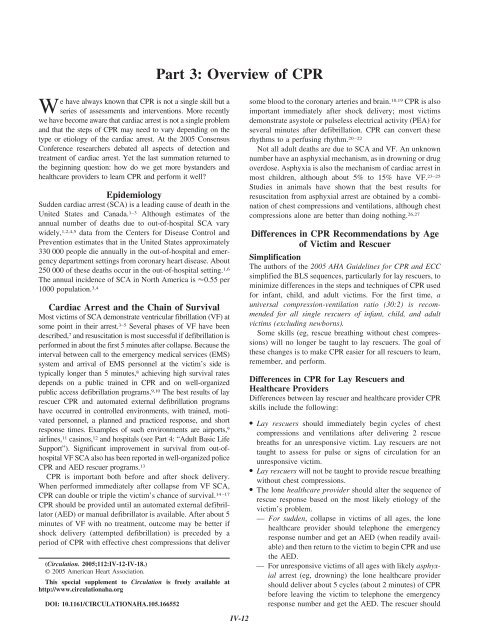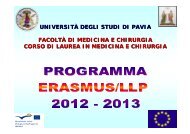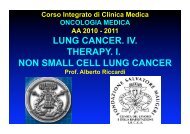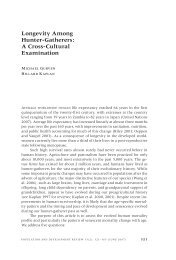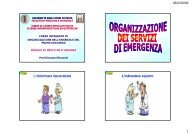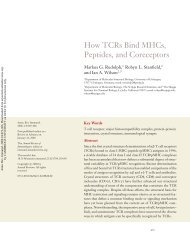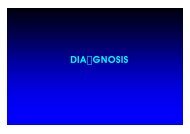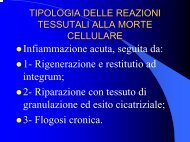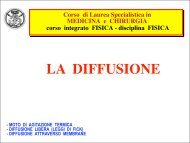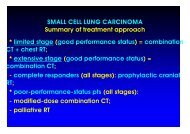Overview of CPR
Overview of CPR
Overview of CPR
You also want an ePaper? Increase the reach of your titles
YUMPU automatically turns print PDFs into web optimized ePapers that Google loves.
We have always known that <strong>CPR</strong> is not a single skill but a<br />
series <strong>of</strong> assessments and interventions. More recently<br />
we have become aware that cardiac arrest is not a single problem<br />
and that the steps <strong>of</strong> <strong>CPR</strong> may need to vary depending on the<br />
type or etiology <strong>of</strong> the cardiac arrest. At the 2005 Consensus<br />
Conference researchers debated all aspects <strong>of</strong> detection and<br />
treatment <strong>of</strong> cardiac arrest. Yet the last summation returned to<br />
the beginning question: how do we get more bystanders and<br />
healthcare providers to learn <strong>CPR</strong> and perform it well?<br />
Epidemiology<br />
Sudden cardiac arrest (SCA) is a leading cause <strong>of</strong> death in the<br />
United States and Canada. 1–3 Although estimates <strong>of</strong> the<br />
annual number <strong>of</strong> deaths due to out-<strong>of</strong>-hospital SCA vary<br />
widely, 1,2,4,5 data from the Centers for Disease Control and<br />
Prevention estimates that in the United States approximately<br />
330 000 people die annually in the out-<strong>of</strong>-hospital and emergency<br />
department settings from coronary heart disease. About<br />
250 000 <strong>of</strong> these deaths occur in the out-<strong>of</strong>-hospital setting. 1,6<br />
The annual incidence <strong>of</strong> SCA in North America is 0.55 per<br />
1000 population. 3,4<br />
Cardiac Arrest and the Chain <strong>of</strong> Survival<br />
Most victims <strong>of</strong> SCA demonstrate ventricular fibrillation (VF) at<br />
some point in their arrest. 3–5 Several phases <strong>of</strong> VF have been<br />
described, 7 and resuscitation is most successful if defibrillation is<br />
performed in about the first 5 minutes after collapse. Because the<br />
interval between call to the emergency medical services (EMS)<br />
system and arrival <strong>of</strong> EMS personnel at the victim’s side is<br />
typically longer than 5 minutes, 8 achieving high survival rates<br />
depends on a public trained in <strong>CPR</strong> and on well-organized<br />
public access defibrillation programs. 9,10 The best results <strong>of</strong> lay<br />
rescuer <strong>CPR</strong> and automated external defibrillation programs<br />
have occurred in controlled environments, with trained, motivated<br />
personnel, a planned and practiced response, and short<br />
response times. Examples <strong>of</strong> such environments are airports, 9<br />
airlines, 11 casinos, 12 and hospitals (see Part 4: “Adult Basic Life<br />
Support”). Significant improvement in survival from out-<strong>of</strong>hospital<br />
VF SCA also has been reported in well-organized police<br />
<strong>CPR</strong> and AED rescuer programs. 13<br />
<strong>CPR</strong> is important both before and after shock delivery.<br />
When performed immediately after collapse from VF SCA,<br />
<strong>CPR</strong> can double or triple the victim’s chance <strong>of</strong> survival. 14–17<br />
<strong>CPR</strong> should be provided until an automated external defibrillator<br />
(AED) or manual defibrillator is available. After about 5<br />
minutes <strong>of</strong> VF with no treatment, outcome may be better if<br />
shock delivery (attempted defibrillation) is preceded by a<br />
period <strong>of</strong> <strong>CPR</strong> with effective chest compressions that deliver<br />
(Circulation. 2005;112:IV-12-IV-18.)<br />
© 2005 American Heart Association.<br />
This special supplement to Circulation is freely available at<br />
http://www.circulationaha.org<br />
DOI: 10.1161/CIRCULATIONAHA.105.166552<br />
Part 3: <strong>Overview</strong> <strong>of</strong> <strong>CPR</strong><br />
IV-12<br />
some blood to the coronary arteries and brain. 18,19 <strong>CPR</strong> is also<br />
important immediately after shock delivery; most victims<br />
demonstrate asystole or pulseless electrical activity (PEA) for<br />
several minutes after defibrillation. <strong>CPR</strong> can convert these<br />
rhythms to a perfusing rhythm. 20–22<br />
Not all adult deaths are due to SCA and VF. An unknown<br />
number have an asphyxial mechanism, as in drowning or drug<br />
overdose. Asphyxia is also the mechanism <strong>of</strong> cardiac arrest in<br />
most children, although about 5% to 15% have VF. 23–25<br />
Studies in animals have shown that the best results for<br />
resuscitation from asphyxial arrest are obtained by a combination<br />
<strong>of</strong> chest compressions and ventilations, although chest<br />
compressions alone are better than doing nothing. 26,27<br />
Differences in <strong>CPR</strong> Recommendations by Age<br />
<strong>of</strong> Victim and Rescuer<br />
Simplification<br />
The authors <strong>of</strong> the 2005 AHA Guidelines for <strong>CPR</strong> and ECC<br />
simplified the BLS sequences, particularly for lay rescuers, to<br />
minimize differences in the steps and techniques <strong>of</strong> <strong>CPR</strong> used<br />
for infant, child, and adult victims. For the first time, a<br />
universal compression-ventilation ratio (30:2) is recommended<br />
for all single rescuers <strong>of</strong> infant, child, and adult<br />
victims (excluding newborns).<br />
Some skills (eg, rescue breathing without chest compressions)<br />
will no longer be taught to lay rescuers. The goal <strong>of</strong><br />
these changes is to make <strong>CPR</strong> easier for all rescuers to learn,<br />
remember, and perform.<br />
Differences in <strong>CPR</strong> for Lay Rescuers and<br />
Healthcare Providers<br />
Differences between lay rescuer and healthcare provider <strong>CPR</strong><br />
skills include the following:<br />
● Lay rescuers should immediately begin cycles <strong>of</strong> chest<br />
compressions and ventilations after delivering 2 rescue<br />
breaths for an unresponsive victim. Lay rescuers are not<br />
taught to assess for pulse or signs <strong>of</strong> circulation for an<br />
unresponsive victim.<br />
● Lay rescuers will not be taught to provide rescue breathing<br />
without chest compressions.<br />
● The lone healthcare provider should alter the sequence <strong>of</strong><br />
rescue response based on the most likely etiology <strong>of</strong> the<br />
victim’s problem.<br />
— For sudden, collapse in victims <strong>of</strong> all ages, the lone<br />
healthcare provider should telephone the emergency<br />
response number and get an AED (when readily available)<br />
and then return to the victim to begin <strong>CPR</strong> and use<br />
the AED.<br />
— For unresponsive victims <strong>of</strong> all ages with likely asphyxial<br />
arrest (eg, drowning) the lone healthcare provider<br />
should deliver about 5 cycles (about 2 minutes) <strong>of</strong> <strong>CPR</strong><br />
before leaving the victim to telephone the emergency<br />
response number and get the AED. The rescuer should


